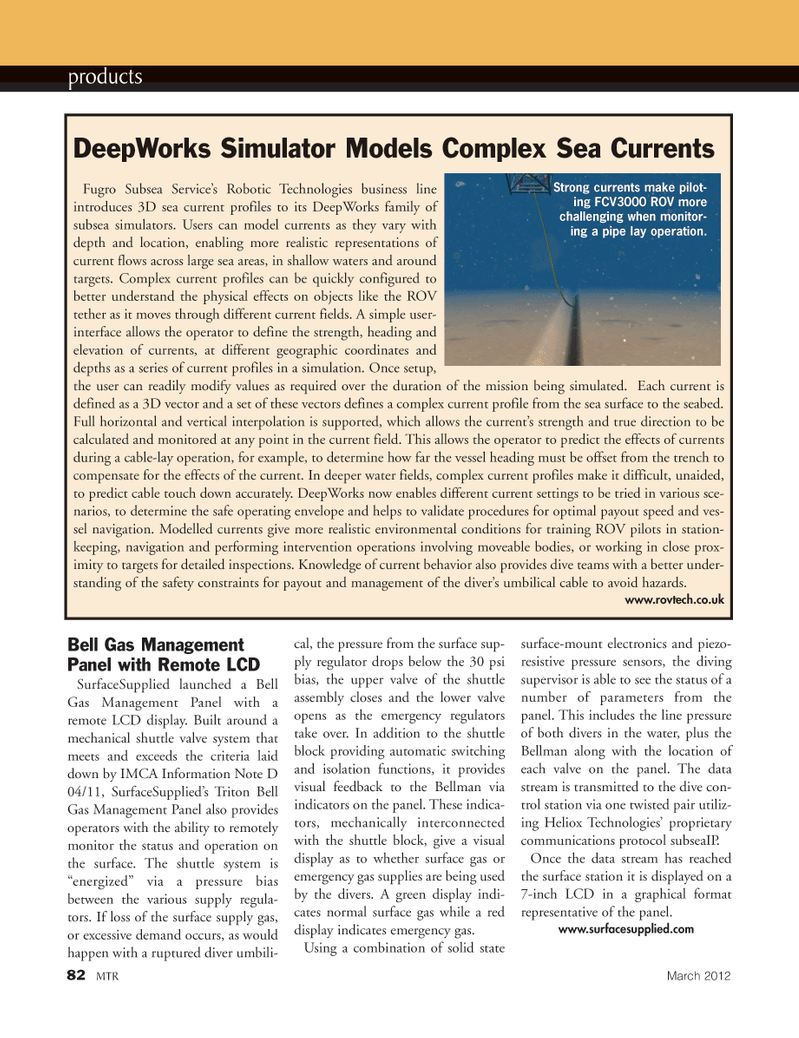
Page 82: of Marine Technology Magazine (March 2012)
Subsea Vehicle Report – Unmanned Underwater Systems
Read this page in Pdf, Flash or Html5 edition of March 2012 Marine Technology Magazine
82MTRMarch 2012 products Bell Gas ManagementPanel with Remote LCD SurfaceSupplied launched a Bell Gas Management Panel with a remote LCD display. Built around a mechanical shuttle valve system that meets and exceeds the criteria laid down by IMCA Information Note D 04/11, SurfaceSupplied?s Triton Bell Gas Management Panel also provides operators with the ability to remotely monitor the status and operation onthe surface. The shuttle system is ?energized? via a pressure bias between the various supply regula- tors. If loss of the surface supply gas, or excessive demand occurs, as would happen with a ruptured diver umbili- cal, the pressure from the surface sup- ply regulator drops below the 30 psi bias, the upper valve of the shuttle assembly closes and the lower valve opens as the emergency regulators take over. In addition to the shuttle block providing automatic switching and isolation functions, it provides visual feedback to the Bellman via indicators on the panel. These indica- tors, mechanically interconnected with the shuttle block, give a visual display as to whether surface gas or emergency gas supplies are being used by the divers. A green display indi- cates normal surface gas while a red display indicates emergency gas.Using a combination of solid state surface-mount electronics and piezo- resistive pressure sensors, the diving supervisor is able to see the status of a number of parameters from the panel. This includes the line pressure of both divers in the water, plus the Bellman along with the location of each valve on the panel. The data stream is transmitted to the dive con- trol station via one twisted pair utiliz- ing Heliox Technologies? proprietary communications protocol subseaIP. Once the data stream has reached the surface station it is displayed on a 7-inch LCD in a graphical format representative of the panel. www.surfacesupplied.com DeepWorks Simulator Models Complex Sea Currents Fugro Subsea Service?s Robotic Technologies business line introduces 3D sea current profiles to its DeepWorks family of subsea simulators. Users can model currents as they vary with depth and location, enabling more realistic representations of current flows across large sea areas, in shallow waters and around targets. Complex current profiles can be quickly configured to better understand the physical effects on objects like the ROV tether as it moves through different current fields. A simple user- interface allows the operator to define the strength, heading and elevation of currents, at different geographic coordinates and depths as a series of current profiles in a simulation. Once setup, the user can readily modify values as required over the duration of the mission being simulated. Each current is defined as a 3D vector and a set of these vectors defines a complex current profile from the sea surface to the seabed. Full horizontal and vertical interpolation is supported, which allows the current?s strength and true direction to be calculated and monitored at any point in the current field. This allows the operator to predict the effects of currents during a cable-lay operation, for example, to determine how far the vessel heading must be offset from the trench to compensate for the effects of the current. In deeper water fields, complex current profiles make it difficult, unaided, to predict cable touch down accurately. DeepWorks now enables different current settings to be tried in various sce- narios, to determine the safe operating envelope and helps to validate procedures for optimal payout speed and ves- sel navigation. Modelled currents give more realistic environmental conditions for training ROV pilots in station- keeping, navigation and performing intervention operations involving moveable bodies, or working in close prox- imity to targets for detailed inspections. Knowledge of current behavior also provides dive teams with a better under- standing of the safety constraints for payout and management of the diver?s umbilical cable to avoid hazards. www.rovtech.co.uk Strong currents make pilot- ing FCV3000 ROV more challenging when monitor-ing a pipe lay operation.MTR#2 (82-96):MTR Layouts 2/22/2012 11:10 AM Page 82

 81
81

 83
83
